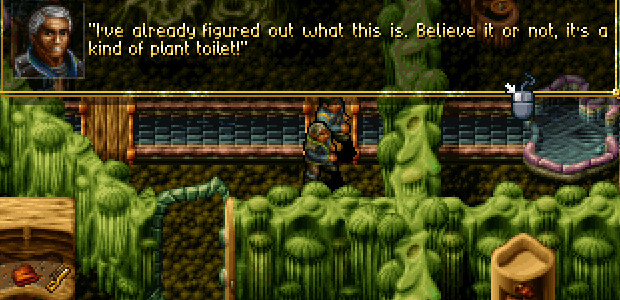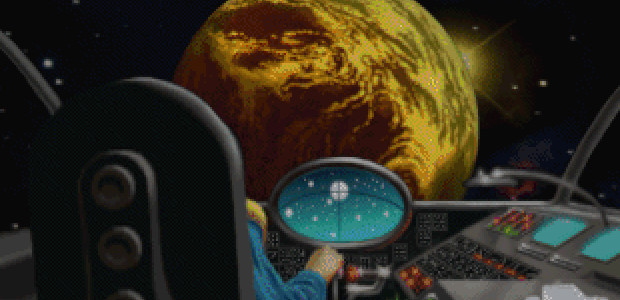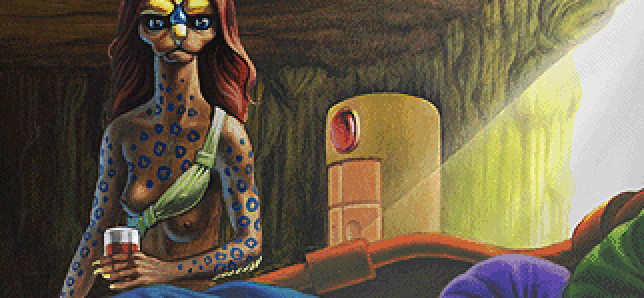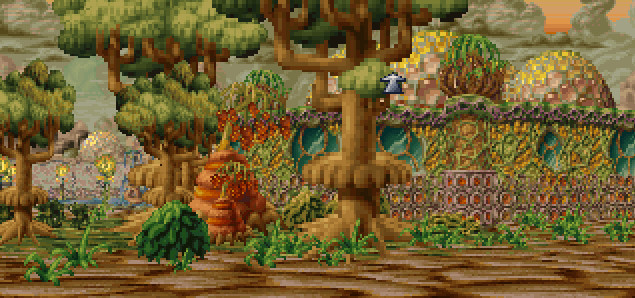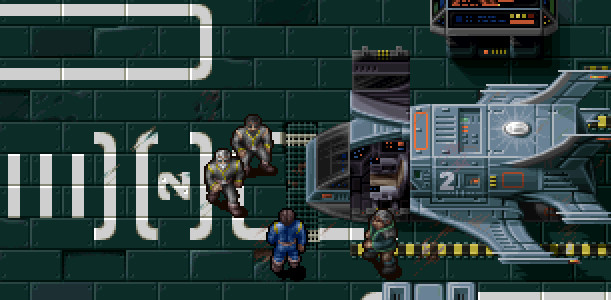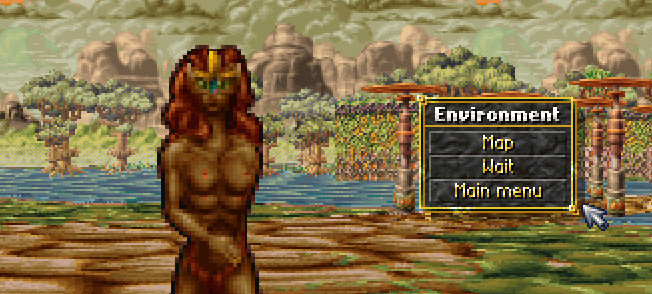The RPG Scrollbars: Serpent In The Staglands
Richard Cobbett on July 13th, 2015 at 1:00 pm.
My first real act as a god was getting killed. By a wolf. Just outside my own sorta-temple.
If any of my followers are listening, write that down in your scrolls and I’ll drop the moon on you.
Serpent in the Staglands [
official site] is a game I’ve been getting a lot of requests to take a look at, and it’s not hard to see why. At a time when everyone seems obsessed with old-school RPGs, here comes one that absolutely embraces the style and yet has slipped under most peoples’ radars. Honestly, that’s not
too surprising. It’s not very pretty, and in attitude, reminds me of
these Mitchell and Webb sketches. “Where’s my handy journal? Starting equipment? Anything that teaches me how to play?” “They’re gone. They’re all gone. And we’re
back. The brutally opaque RPGs that spit in your face for not being one of the designers. Oh, I saw you in character customisation, picking skills because you thought they sounded ‘cool’. Go back to your Dragon Age. You make me
sick.”
Luckily, it’s got a few things on its side from the start too, not least a fun premise and setting. You’re the god of the moon who likes to head down to the mortal world on a regular basis, suddenly finding yourself unable to get back home. With no allies save for a lord you’ve blessed over the years, and needless to say, no divine power, your only hope is to masquerade as a travelling spicer and slum it on foot through a Slavic flavoured world armed with nothing more impressive than a kitchen knife and some stolen travel papers. And that was after searching. Fists against wolves? Not recommended.
With a little equipment though, it’s a good start, kicking off with a dark mirror of Ultima’s character-creation-by-gypsy system that lets you determine what kind of god you are, and with a script that doesn’t forget it. Pretty much every conversation gives you the option to throw your weight around in blissful ignorage of the fact that you don’t have any right now. Always entertaining.
It’s this layer of character that carries the game through the needlessly frustrating opening, which largely assumes you’re coming to the game from things like Dungeons and Dragons with clarifications like “Strength gives a natural bonus to hit damage for melee and range fighters. Phys Damage: (above base)Strength/2 + equipped weapon damage + item/skill mods.” There’s a lot to juggle in both the raw rules, from that, to the different skill trees that handle basic stats and skills and Aptitudes, which give additional options in certain situations, to the point that I ended picking up most of it by sheer accident. There’s an early quest for instance where a farmer wants you to get rid of a fox from his field, and it was only in the ‘I defeated the foul beast’ options that I saw the option indicating that had I put a point into the right Aptitude, I could talk to it and persuade it to leave.
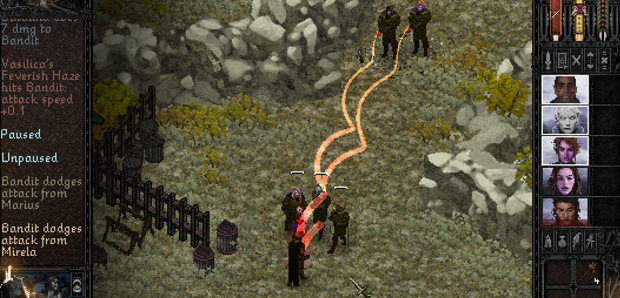
Even on a basic level though, annoyance abounds. There are barrels all over the world, but you can’t smash
those barrels, only
these barrels. You pick up emeralds, but then they don’t appear in your inventory because it turns out that those are cash rather than valuable goods. A character will say something like “There’s something in the well”, and the well is clickable, but clicking on it doesn’t actually
do anything. Or at least, doesn’t seem to. And so on. Sometimes you smash a barrel but instead of getting items, everyone just falls on their arse because it was full of oil. Thanks!
This game painfully, desperately needs a Getting Started type guide. There’s a manual, which is
not optional, but even that is a weak introduction. It’s not complex because the systems are rocket science, but because everything is either poorly explained or just plain not explained at all. I’m aware that to some people that is considered hardcore, but I call bullshit. Games like Darklands had brutal introductions
not because scourging is simply good for the soul, but because circa 1992 there usually
weren’t any alternatives. Some twenty odd years later, game design by the same rules is like dealing with a civil servant who piously demands all of his staff write memos to him in Latin.
(This is not the same for all its pointedly old-school decisions, mind. To name one, Serpent’s preference for giving you a journal to fill in rather than giving you one that automatically fills itself in feels like a reasonable throwback that fits the style. That at least means you’re never just treading waypoints, and the open world will allow you to go more or less anywhere if you can survive the monsters or find ways to kite them into guards who can then handle them for you. There’s already at least one speed-run of the game that’s only 42 minutes long, and much of that is spent on the achingly slow loading screens. I guess at least they add an extra sting to failure?)
The frustrating/good thing is that behind all of this waits a surprisingly good RPG. It’s bursting with carefully designed areas and clever ideas, as well some really fun gimmicks. You can start with just yourself, or use your god powers to create a few extra empty shells to back you up until you find suitable NPCs to fill slots. When they’re recruited, you can either take them warts and all or use your power to just straight up steal their souls, removing their tiresome free will.
“You grip his shoulder as if he was a comrade and feel the vitality of his blood coursing in his veins. Digging deeper you find his soul, vulnerable and ripe, and whispering the incantation known only to the gods, you mark his soul as yours.”
Oooh.
Similar moments are all over the place, from the arrogant conversation options to weird little asides like being able to greet ducks with a cheery “What ho, duck!” that I find far funnier than I probably should, to the inevitable moments of RPG bastardry. There’s a particularly fine bit in the first proper town, down to the South, where a suspicious ship captain will buy a party member’s contract from you for a nice chunk of change, as long as you don’t have any moral objections to quite clearly selling someone into indentured servitude. Or at least, not more than about 200 emeralds worth of them. When ambushed out in the wilds, you get a cute little bit of flavour text to say that you’re not just jumped by goblins, but get waylaid while following a shortcut, or foraging for food. Early on you can find yourself facing “Crap Goblins”, and again, I find that far, far funnier than I probably should.
While this is all obviously window-dressing, it’s the kind that neatly shows the love and care that’s also gone onto the solid and (eventually) enjoyable RPG core. As much of a pain as Serpent in the Staglands is to get started with, it does reward the effort by combining its nostalgia with new ideas and a fun design sensibility that seems to leave it feeling almost embarrassed to be more modern than it wants to be – a throwback to the 90s that does its quests and world design the way that those games secretly always wanted to but were too constrained by the technology of the time to fully realise. This was after all the era where games like Wasteland had no choice but to put most of their plot text into a manual and have the game give page look-up instructions at the right point. As with many nostalgia-fueled RPGs, that leaves Serpent of the Stagland in a good place to emulate the era of games as you remember it, minus some of the more irritating elements that got in the way.
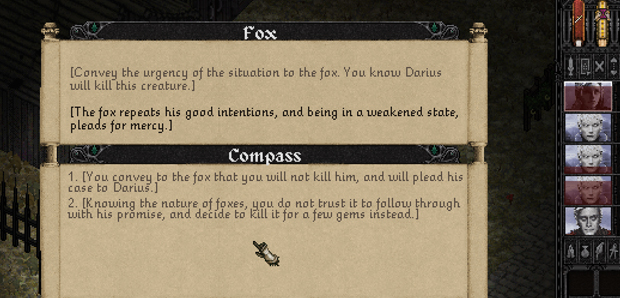
All of this should give you a pretty good idea of whether Serpent in the Staglands is likely to be ‘your’ game or not. In short, there’s a lot of really good stuff here, and the game is mostly excellent, but the path to actually getting
into the damn thing is far more frustrating than it is rewarding. Once past it, the amount of freedom it offers in everything from character builds to your path around an open world designed to reward exploration is all great, and knowing the carrot is there does help. Even so, do be sure you have the dedication to keep chasing it while being brutally beaten with the stick.







![Have Many Potato [2013] Codex 2013](/forums/smiles/campaign_tags/campaign_potato2013.png)
![The Year of Incline [2014] Codex 2014](/forums/smiles/campaign_tags/campaign_incline2014.png)



















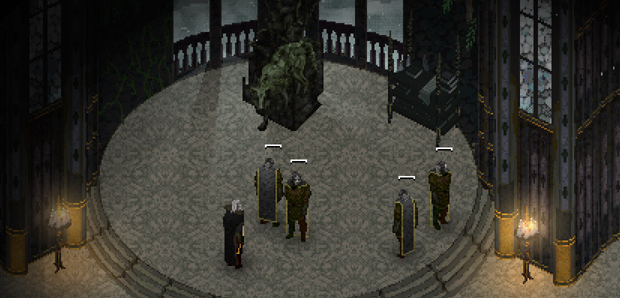
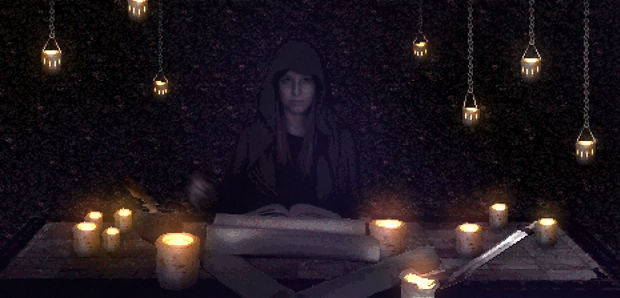

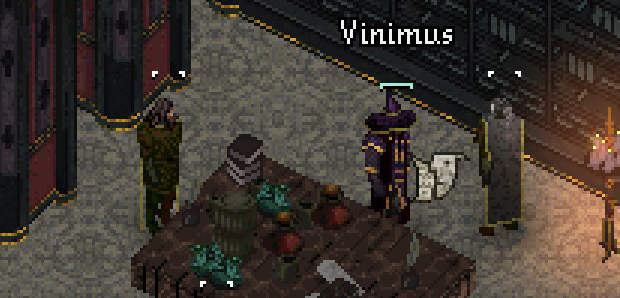


![Glory to Codexia! [2012] Codex 2012](/forums/smiles/campaign_tags/campaign_slushfund2012.png)











